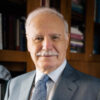During the past couple of years, courtesy of the Covid-19 pandemic, all educators and institutions have been violently made aware of the necessity to greatly increase the integration of digital technologies and data in education. Doing so, however, has been a challenge to say the least, mainly because of the short window of time during which the transition took place, but also because having to adopt and adapt to numerous different technologies at the same time was trying for educators and students alike.
In this issue of Business Partners, we have asked Thought Leaders in education to share their views on the importance of creating a comprehensive digital education ecosystem to support future-ready lifelong learning systems. They also share their views on the necessity for policymakers, educators and EdTech companies to work together, explain how their respective institutions are moving toward this direction, and discuss the challenges and opportunities of the future of education.

Digital Technologies in Education
By Sophia Katsaouni, Headmaster, Othisi High School
Digital technologies have become an integral part of education in developed countries in recent years and their use is spreading at light speed. However, their widespread use by students and educators poses challenges and raises a number of questions to be tackled by the educational community.
Digital technologies in education are here to stay, and rightly so
To begin with, the question arises of how pervasive digital technology should be in education. For instance, should tablets and e-books replace notebooks and printed books? Will that be a boon or a menace for students in the long term? Policymakers should try to strike a balance. Another issue to be considered is educators’ different levels of technological competence. With an aging population of teachers, who can guarantee acquisition and training regarding digital skills? Can this be left to individual initiative and conscience? It is necessary that there be a coherent digital policy for this matter. Training and university curricula should focus on technological pedagogical content knowledge rather than on specific tools that become outdated in no time. Furthermore, all interested parties, policymakers, educators and EdTech companies should work closely together to create student-specific systems so as to avoid using for educational purposes platforms created for professional fields, which proved to be problematic during distance learning.
All things considered, digital technologies in education are here to stay, and rightly so; they provide infinite opportunities through flipped classrooms, differentiated teaching and development of computational thinking, to name just a few, which help address numerous challenges such as students’ multiple intelligences and learning difficulties. However, careful planning is imperative in order to reap the benefits of an undeniable and unprecedented advance.

Culturing Global Competencies
By Dr. Iro Koliakou, STEM Coordinator, Anatolia College
Our world is changing fast, driven by new scientific knowledge and technological advancement. In order to catalyze innovation, creativity and job sustainability in Industry 4.0, we need to invest in STEM programs. According to the OECD Learning Framework 2030, “Education needs to do more than prepare young people for the world of work; it needs to equip students with the skills they need to become responsible and engaged citizens.” Students need support in developing not only knowledge and skills but also attitudes and values. Global competencies for the future include creating new value, taking responsibility, and reconciling tensions and dilemmas.
The Anna Papageorgiou STEM Center at Anatolia College was designed in order to provide an environment for innovation and meaningful learning opportunities. The building itself is an educational instrument, a visible learning tool, exemplifying a sensitivity to environmental impact. Students and educators can use the digital information system provided to measure real-time energy production and consumption and explore the environmental impact of its bioclimatic design. There is also a multipurpose teaching room that is equipped with virtual and augmented reality tools that aim to promote engagement and nurture better understanding.
Future education needs to prepare tomorrow’s leaders in order to advocate for a more equitable and just world. Anatolia College has always valued and emphasized innovation, inclusiveness, and diversity, and as a non-profit educational institution, we have a mission to lead by example. To this end, we launched the MiniOpenLabs project, which relies on the use of opensource software, to test various methodologies and disseminate innovative practices to the whole educational community through collaborations and outreach programs open to all.

Reshaping Learning
By Leonidas Koskos, Chairman of the Board of Directors, Hellenic American Union
On both sides of the Atlantic, Covid-19 signaled a dark hour for educational institutions, of which some collapsed, some barely survived, and some excelled. Hellenic American Union (HAU) belongs to the latter. When the Greek government announced the first lockdown, HAU switched its entire operations to digital overnight, without missing a single hour of classes or office work, and HAU’s academic team also helped Hellenic American University/Hellenic American College to go digital instantly. This shift did not just happen. It was thanks to prudent choices five years back, when the joint vision of HAU’s leadership and community to invest heavily in our institutions’ technological infrastructure ushered us to our finest hour.
The determination and long-standing commitment of the entire HAU community in Athens and Nashua to the value of digital education allowed our institutions to live up to the challenge. The winter of discontent never reached us. Our classes ran because of the state-of-the-art eLearning platforms and the academic team of experts working under the coordination of Dr. Tolias, Dean of Education Innovation. Under the supervision of Dr. Geka, Deputy Director of the Center for Language Studies, our teachers and students entered their virtual classrooms and held their classes from various locations, having undergone vigorous and fast training that turned them into effective digital educators. Our people worked remotely thanks to the digitalization scheme initiated by our CEO, Vicky Branika, and implemented by our expert IT staff. Out of this endeavor emerged not only a center for teaching excellence, dedicated to the service of our community, but also a dynamic model of a hybrid classroom that reshapes learning.

Some Uncomfortable Questions
By Dr. Nikos Mylonopoulos, Associate Professor of Digital Business and Director of the SEV Center of Excellence in Creative Leadership, Alba Graduate Business School, The American College
Even though almost every sector today is unrecognizable compared to a century ago, anyone from the early 1900s would find what is going on in schools and universities today quite familiar. However, new ways of thinking are slowly emerging, giving rise to some uncomfortable questions. For example, given the proven feasibility of remote and hybrid lessons, we must seriously confront the question of what meeting in person is good for. If innovative workplaces allow employees to work from anywhere three days per week, why should we insist that students travel to the classroom every day?
We are compelled to revisit the fundamentals of what we do and why we do it
Given the abundance of free knowledge in every conceivable format, we must ask ourselves whether listening to an instructor recite a lesson live is the best way to learn. If so many children and adults alike can make things, solve problems, and change careers by means of online discovery, why should we insist that the classroom format is best?
Given the constant demand for emerging skills that take too long to incorporate into formal curricula, we must question the point of assessing and certifying knowledge that may already be or soon become obsolete. If employers increasingly hire for values and attitude, taking for granted that requisite skills change and can be learned more easily, what is the true value of exams and degrees?
While classroom teaching, exams and degrees will not be altogether abolished, we are compelled to revisit the fundamentals of what we do and why we do it if education is to become once more the force that leads society into the future.

Leading Change from Within
By Dr. Peggy Pelonis, President, ACS Athens
The workforce today requires people who understand themselves and their world at a higher level of mental complexity
Change is a constant in our lives. Change happens with or without our consent on multiple levels: within us, between us, among us, and beyond us. With technological advances, change is now faster than ever and the frequent developments in science and technology have created a global economy also characterized by rapid change leading to higher levels of competition and demanding higher levels of education and training, greater capacity for innovation, self-management, personal responsibility, and self-direction. As the workforce today requires people who understand themselves and their world at a higher level of mental complexity, the psychological demands are massive. Thus, the younger generations must cope with change, navigate change, create change and shape change—because they must be problemsolvers, able to generate options and look at possibilities lest they be victims of change. Education therefore must also change if we are to keep up with the challenges. Educators and leaders must think differently; they must be learners—lifelong learners—who in turn inspire students to be lifelong learners prepared to lead and navigate change. When a school is intentionally positioned to develop responsible, conscious, reflective people, it empowers students to acquire the skills and knowledge to ensure future success, but also to acquire the values and mindsets to make decisions that improve human lives and life on the planet. Such an educational model rethinks the school as a professional learning laboratory and aims for students to develop a leadership identity guided by ethical decisionmaking. The outcome of this remodeling is a school culture not simply responding to change, but leading change within and beyond the institution.

Essential Shifts in Education
By Natalie V. Pinakidou, Digital Design Instructor/Ed Tech Coach, Pinewood American International School
The main advantages of technology in education are the possibilities it creates to design interactive learning environments for our students, help with differentiated instruction, and provide distance learning, as we experienced during the pandemic. It is evident in current research that the integration of new technologies in education has preoccupied the scientific community as scores of investigations concerning the possibilities offered by new technologies in teaching and learning have been conducted in the past two years.
As Brown and Green suggest in The Essentials of Instructional Design, “The traditional approach has been for an educator to focus on the information that should be included in the lesson; instructional design demanded that the educator add to that some consideration for how the information was to be organized and presented based on what is known about the learners and their abilities.” At Pinewood, we interpret this as an outline for three essential shifts in education that we work to implement for authentic student engagement: from teacher-centered to student-centered; from students as empty vessels to students with valuable prior knowledge; and from learning by viewing to learning by doing.
Whether we use the computer as a medium for distance learning or in a classroom setting as part of the instructional experience, teachers must redefine their whole approach toward the educational process in order to embrace effectively the technological advances of this century. Teaching is an art, and it takes artistic skills to incorporate new technology in the classroom in order to support students to reach their full potential as adaptable global citizens.

Preparing for a Hybrid Academic Journey
By Dr. Manos Varouchas, Associate Professor and Department Head of Management Information Systems, Deree, The American College of Greece
The outbreak of the Covid-19 pandemic has challenged higher education institutions to rethink and redefine their educational models, leaving behind old views on the inability and inefficiency to deliver academic programs in online synchronous or asynchronous mode. They have accelerated the transformation from physical to digital interactions and have managed to achieve the pertinent program learning outcomes. To adapt to the digital imperative, educators and students have demonstrated a high degree of agility by boosting their digital skills to be able to effectively interact in online settings. Nevertheless, the rate of technological change presents new challenges for both educators and learners. The question posed is whether universities have the capacity to continue transforming so that they can shape a hybrid educational environment that allows room for both traditional and digital education.
The answer lies in the creation of a hybrid academic journey integrating the best features of the two worlds. The underpinnings of this journey should include among others the review of the pedagogical teaching methods, the leveraging of technologies already adopted, and the strengthening of the curricula with educational technologies. The highlight of this journey is that learners will learn how digital technologies support their education and develop the digital acumen to evolve from passive technology users to knowledge workers. Additionally, to avoid a bumpy journey, universities are expected to provide educators with opportunities for digital upskilling. But above all, they should decide on a suitable digital culture to give this journey meaning.

Covid-19: A Missed Opportunity for Assessment Reform
By Matthew Williams, Headteacher, Byron College
Education as we know it today is a product of the Victorian era, and since this time there has been a great deal of necessary educational change, all for the better. Much like the Victorians bore witness to the industrial revolution, the past three years of the global pandemic have made us all re-examine our lives and given birth to an educational revolution of sorts. The teaching community proved its adaptability and innovation as the world’s classrooms moved online to ensure that our students continued to receive the best possible experience. However, despite the many positive changes, the way in which we assess and award final grades has not changed since the onset of modern education in the 1800s. The pandemic was a serendipitous opportunity to address our archaic assessment methods, but sadly the examination boards failed to seize this opportunity.
The pandemic was a serendipitous opportunity to address our archaic assessment methods
Education is not the flawed institution that some would suggest, but because of the testing that is imposed on us, it remains a one size fits all system. We go to great lengths in our schools to promote inclusion and ensure that no individual falls behind, but these efforts stumble at the final hurdle. Exam boards set uniform assessments, still frequently rooted in what differs little from Victorian rote learning practices. Where is the application of knowledge in these assessments? Where is the synthesis of knowledge from different subject areas? It is time for exam boards to join the revolution and stand as part of a community of educators and promote modern, innovative forms of assessment that are reflective of the wonderful work that our teachers do.

Social-Emotional Ethical Learning and Digital Technology
By Michael Wolper, School Director, Verita International School
If anything has brought educators together over the last two years, it is the feeling of vulnerability about the present and uncertainty about the future. With over 80% of students affected by recent school closures, there has been an accelerated need for schools to undergo a digital transformation. Coupled with concerns on students’ social and emotional wellbeing, there is a renewed urgency to bring together educational technology and social-emotional ethical learning skills.
Meaningful, authentic learning requires connected and social engagement at the core
Most countries have identified digital learning and building students’ digital competencies as a key priority. The pandemic has exacerbated this need. Technology has clearly become a ubiquitous and essential part of education. And while there is minimal data measuring students’ social and emotional wellbeing, as educators, we see the impact on our children: learning losses, behavior issues, increased anxiety and stress. Education is beginning to understand the need for new success metrics and the importance of wellbeing.
Social-Emotional Ethical Learning (SEE) has quickly become the evidence-based solution to address these challenges. SEE supports students in developing the knowledge, skills, and behaviors necessary to navigate emotions, exhibit prosocial behavior, and cope with life’s daily challenges. These soft skills have often been sidelined, especially in EdTech, in favor of hard skills (coding, programming, data analytics), but this focus is being reevaluated as we learn that they are interdependent and necessary for longterm measures of success.
At first, integrating SEE, rooted in managing emotions, with technology seems counterintuitive. Meaningful, authentic learning requires connected and social engagement at the core. But schools need to recognize that digital solutions can help bridge this gap. Using technology, education has the power to enhance connections, amplify students’ voices, share digital learning and storytelling, and promote social-emotional ethical learning across disciplines and cultures, with accessibility for all. These are big visions, and the timing is ripe for it.






